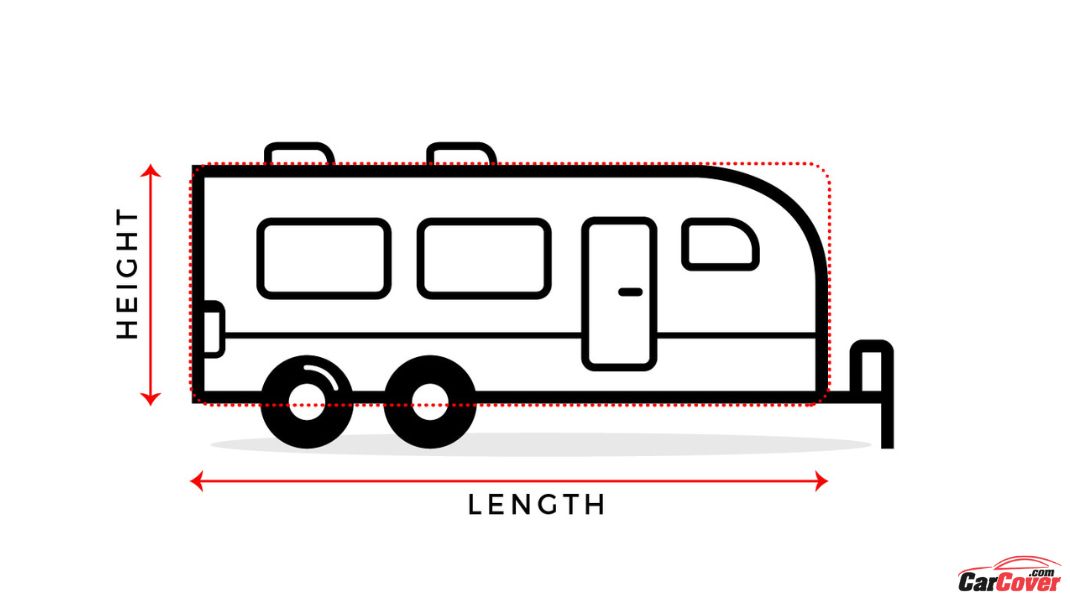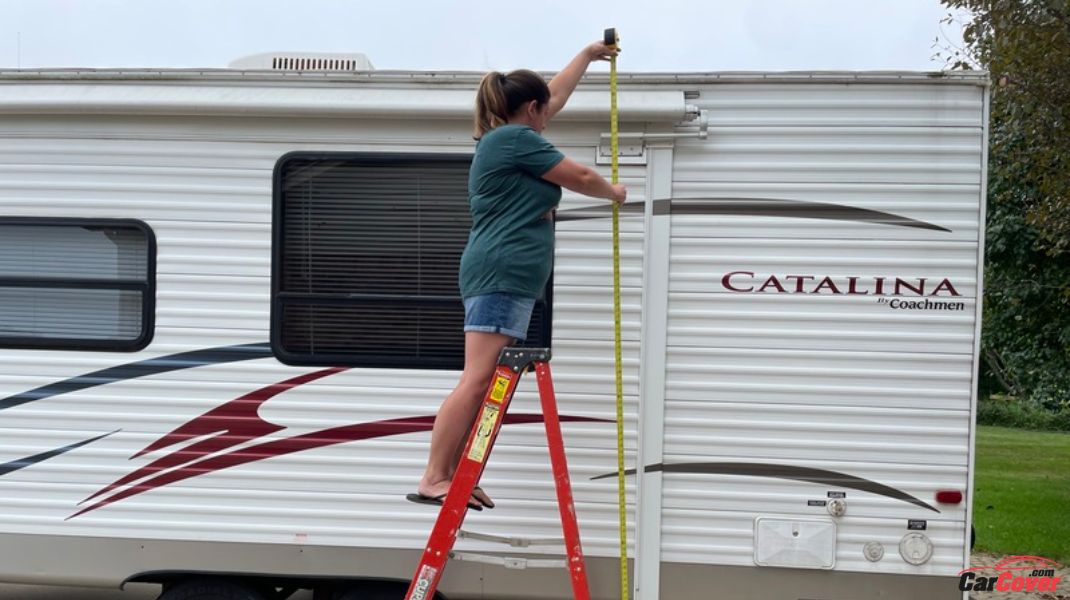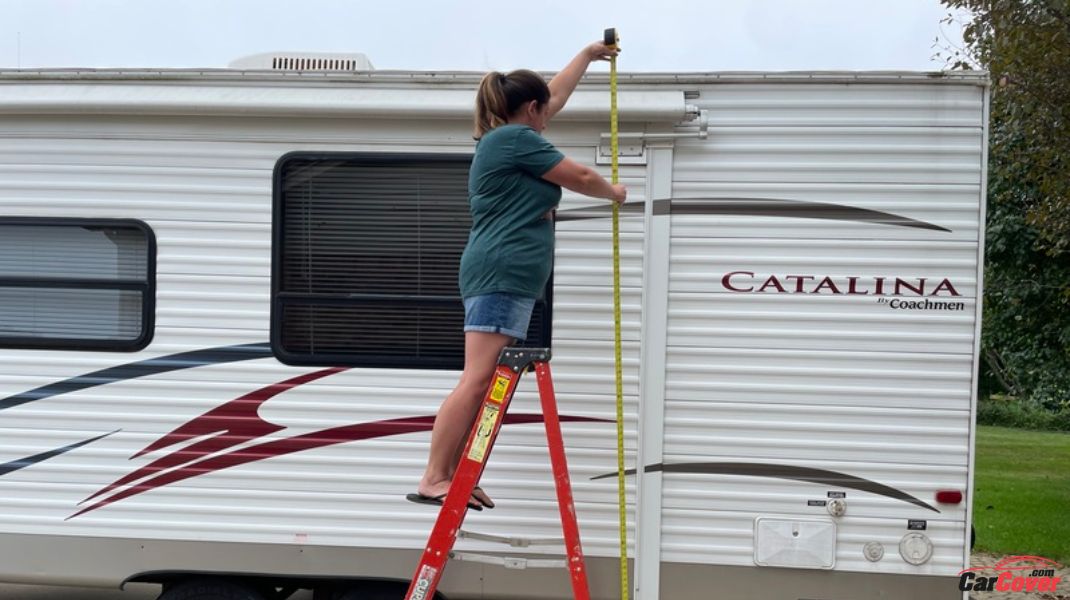To measure a camper for a cover, determine the length, width, and height of the RV. Exclude bumpers, hitches, and ladders in your measurements for the best fit.
Protecting your camper with the right cover is crucial for its longevity and maintaining its condition. A well-fitted cover shields your RV from harsh weather, dust, and debris. Before purchasing a cover, obtaining the exact dimensions of your camper is essential.
This process involves measuring the camper from end to end, including the body and additional elements like air conditioners or antennas on the roof. Selecting the appropriate cover size ensures your investment stays secure and reduces the risk of damage from environmental elements. Read on for a step-by-step guide that helps you measure your camper accurately, ensuring you choose a cover that provides maximum protection.
Introduction To Camper Protection
Keeping a camper safe is important. A cover protects it. Rain, sun, and dirt can damage campers. A cover helps avoid these. But, the cover must fit well. A bad fit can cause problems. Let’s learn how to measure a camper for a perfect cover.
Importance Of A Proper Fit
- A good fit keeps the camper dry.
- It prevents wind from tearing the cover.
- A snug cover stops dirt and leaves from getting inside.
- It helps the cover last longer.
Consequences Of Incorrect Sizing
- A loose cover can tear easily.
- Water might pool on a saggy cover, causing damage.
- Too tight covers can scratch the camper.
- The wrong size can expose parts of the camper.
To measure your camper:
- Measure length from bumper to bumper.
- Include extras like ladders or racks in the length.
- Measure height from ground to roof, excluding AC units.
- Measure the width from one side to the other at the widest point.
Write these numbers down. Use them to find a cover that fits well.
Types Of Camper Covers
Protecting your camper is key. A cover keeps it safe from weather and dirt. You need the right type. Let’s explore cover types for your camper.
Universal Vs. Custom Fit
Two main cover types exist. Universal covers fit any size. They are less expensive. Custom-fit covers match your camper’s shape. They provide better protection but cost more.
Material Considerations
Different materials offer various benefits. Some resist water well. Others protect against UV rays. Choose a material based on your camper’s storage location.
- Polypropylene: Good for water resistance.
- Polyester: Strong against UV rays.
- Solution-Dyed Acrylic: Best for long-term use.
Preparation Before Measuring
Measuring your camper for a cover is important. A good fit keeps your camper safe. Before you start, you must prepare. Preparation makes measuring easy and accurate. Cleaning And Clearing The AreaFirst, clean your camper. Dirt can affect the measurement. Use soap and water. Make sure the camper is dry. Next, clear the area around your camper. You need space to move. Remove any items that can get in the way. Tools Needed For Accurate MeasurementYou need the right tools for measuring. Here is a list:
- Tape measure: A long one is best.
- Notebook and pen: To write down measurements.
- Helper: Another person can make it easier. With these tools, you are ready to measure your camper correctly.

Credit: www.carcover.com
Step-by-step Measuring Process
Protecting your camper with the right cover is essential. A good cover keeps your camper safe from weather damage. But first, you need to know the right size. This guide makes measuring your camper easy. Follow these simple steps to find the perfect fit.
Determining The Starting Point
Begin at the camper’s front end, not including the hitch. This is where you’ll start all your measurements. Make sure your camper is on level ground. This helps you get accurate measurements.
Measuring Length
To measure the length, use a tape measure. Start at the front end, where you determine your starting point. Stretch the tape measure to the very end of the camper’s body. Don’t include bumpers or spare tires. Write down the number in feet and inches.
Measuring Width
Next, measure the camper’s width. Start at the widest point of your camper. This is usually near the middle. Measure straight across to the other side. Remember, some parts like awnings or mirrors should not be included. Note the width in feet and inches.
Measuring Height
Lastly, measure the height. Start from the ground level. Then, measure straight up to the top, not including any AC units or antennas. Use a ladder if needed, but be safe. Write this number down too.
With these measurements, you can find a cover that fits your camper perfectly. Remember, a snug fit is important. It prevents the cover from flapping in the wind. This guide helps you protect your investment easily and effectively.
Accounting For Unique Features
Measuring a camper for a cover is not just about length, width, and height. Unique features of your camper can affect the fit of a cover. These features include air conditioners, ladders, and spare tires. Proper measurement ensures your cover will protect your camper fully.
Handling Protrusions And Accessories
Camper accessories stick out. They need special attention. Follow these steps:
- Identify all items that protrude.
- Measure each item’s size.
- Add these measurements to the camper’s overall dimensions.
This ensures a snug fit. The cover must encompass all extra parts.
Special Considerations For Roof Elements
The roof has elements like AC units and vents. Measure these carefully:
- Check the roof for any extra items.
- Measure the height of each element.
- Add the tallest element’s height to the camper’s height.
A proper fit depends on these details. Your cover should not be too tight or too loose.
Tips For Ensuring Measurement Accuracy
Measuring a camper for a cover is key to protecting it. Right measures keep your camper safe. We will share tips to ensure you do it right.
Double-checking Numbers
Measuring once is not enough. Always measure twice. This makes sure you do not make mistakes. Use a reliable tape measure. Start from the camper’s front to its back. Include bumpers, spare tires, and ladders in your length measure. For height, measure from the ground to the highest point, but do not include AC units. Write down all the numbers. Ask someone to check your measures too.
When To Seek Professional Help
Sometimes, measuring a camper is hard. This can be true for large or oddly shaped campers. Do not guess if unsure. Seeking help from a professional is smart. They have the tools and knowledge. They ensure your camper’s cover fits perfectly. This protects your investment.
- Remember: Accurate measures protect your camper.
- Tip: Use a metal tape measure for more accurate results.
Following these steps will help you get the right cover. Your camper stays safe and looks good.
Selecting The Right Cover After Measuring
After measuring your camper, the next step is choosing a cover. The right cover protects your camper from weather and wear. Let’s explore how to pick the perfect fit.
Understanding Cover Ratings
Camper covers come with different ratings. These ratings tell you how well they protect. Look for these ratings:
- Water Resistance: Keeps water out.
- UV Protection: Shields from sun damage.
- Breathability: Prevents mold by letting air in.
- Durability: How long the cover will last.
Dealing With Sizing Variations
Camper sizes vary. So do cover sizes. Follow these steps for a good fit:
- Match cover size to camper size.
- Check cover dimensions against your measurements.
- Consider extra features like ladders or air conditioners.
- Choose a slightly larger cover for easy fitting.
Installation Of The Camper Cover
Properly installing a camper cover keeps it safe from the weather. This guide helps. Follow these steps.
Step-by-step Guide
- Unpack the Cover: Lay it flat near the camper.
- Find the Front: Covers have tags saying “front”.
- Place on Camper: With help, put the cover on.
- Secure the Cover: Pull it down evenly on all sides.
- Strap it Down: Buckle the straps under the camper.
- Adjust Fit: Pull straps tight for a snug fit.
- Check Corners: Ensure corners are well covered.
- Inspect: Walk around to see if the cover fits well.
Common Challenges And Solutions
| Challenge | Solution |
|---|---|
| Cover Too Tight | Stretch gently and adjust the straps. |
| Straps Not Holding | Check the buckles and tighten them again. |
| Too Much Material | Tuck excess under straps. |
| Can’t Find Front | Look for the tag marked “front”. |
Maintenance And Care For Camper Covers
Caring for camper covers is key for longevity. Proper maintenance saves money. It prevents wear and tear. Clean covers regularly. Store them correctly when not in use. Follow these tips for the best care.
Cleaning Your Camper Cover
Clean covers extend life and look good. Use mild soap and water. Rinse well. Avoid harsh chemicals. They damage the fabric. Dry the cover fully before storing. This prevents mold and mildew.
Storage Tips When Not In Use
Proper storage is crucial. Keep the cover in a cool, dry place. Use a storage bag if available. Fold the cover neatly. This avoids creases and damage. Check the cover for damage before storing. Repair small issues to prevent bigger ones.

Credit: m.youtube.com
Troubleshooting Common Fit Issues
Getting the right cover for your camper matters. A poor fit can lead to damage. Let’s fix common fit problems.
Adjusting For A Tight Fit
A tight cover strains the fabric and zippers. It can tear. Follow these steps to adjust a tight cover:
- Measure your camper again. Include bumpers, ladders, and spare tires.
- Check the cover’s size range. It should match your camper’s dimensions.
- Loosen straps and buckles on the cover. This gives more space.
- Ensure the cover is even. Pull gently to cover all parts.
Solutions For A Loose Cover
A loose cover flaps in the wind. It wears out fast. Use these solutions for a better fit:
- Start at the front. Tighten the straps and pull the cover taut.
- Adjust the elastic hem. This secures the bottom edge.
- Use additional straps or weights. They keep the cover in place.
- Consider a custom-fit cover. It matches your camper’s shape.
Upgrades And Customizations
Protecting your camper means getting the right cover. Let’s make that cover better. Upgrades and customizations can help. They make the cover last longer and look good. Here’s how to add extras to your camper cover.
Enhancements For Durability
Durable covers protect better. Here are ways to make your cover tough:
- Thicker Material: Choose heavy-duty fabric. It resists tears and weather.
- Reinforced Corners: Extra fabric at corners prevents holes.
- Waterproof Coating: A waterproof layer keeps rain out.
- Ventilation Flaps: These stop mold and mildew.
Adding Personal Touches
Make your camper cover unique. Add these personal touches:
- Color Choices: Pick a color that matches your style.
- Custom Graphics: Print names or logos on the cover.
- Reflective Strips: They make your camper seen at night.
- Pocket Add-ons: Extra pockets store gear.

Credit: www.carcover.com
Conclusion
Measuring your camper for the perfect cover is straightforward with the right steps. Ensure accuracy by double-checking dimensions and accounting for accessories. A snug, protective cover extends your camper’s lifespan, keeping it ready for your next adventure. Happy measuring and safe travels!

